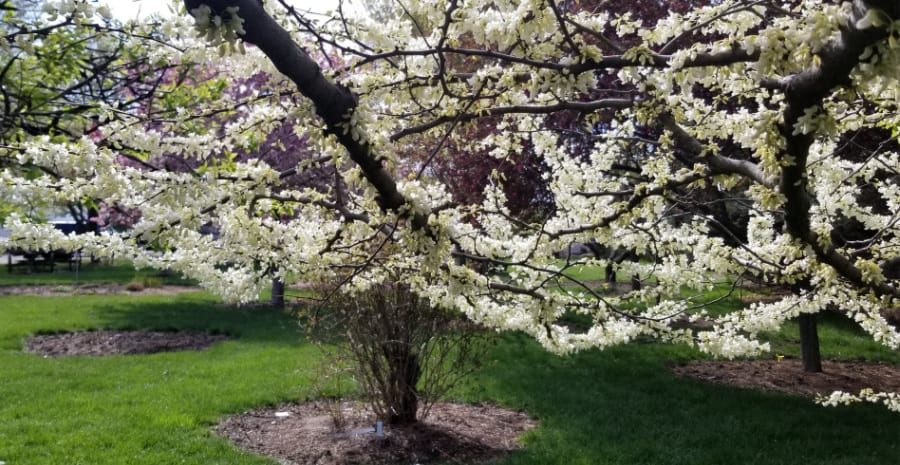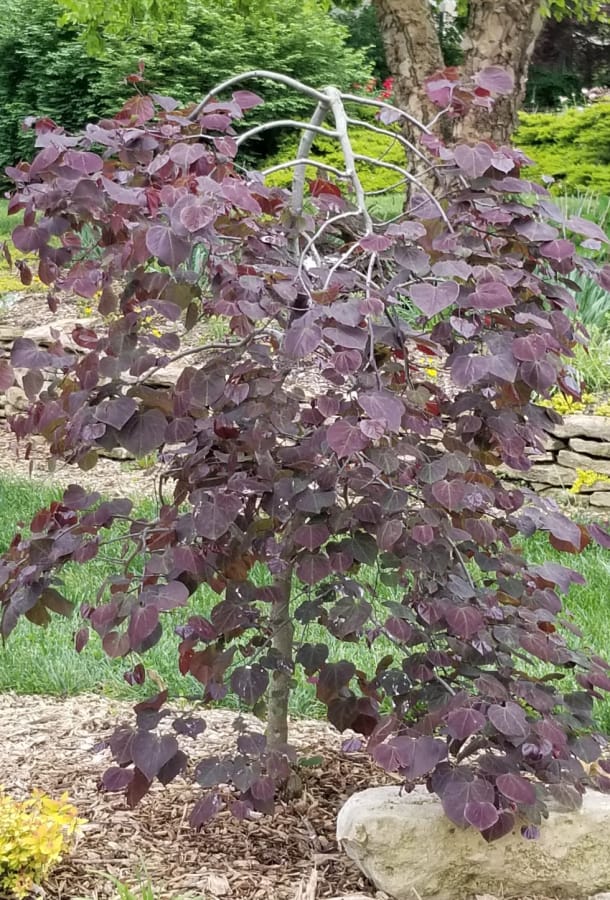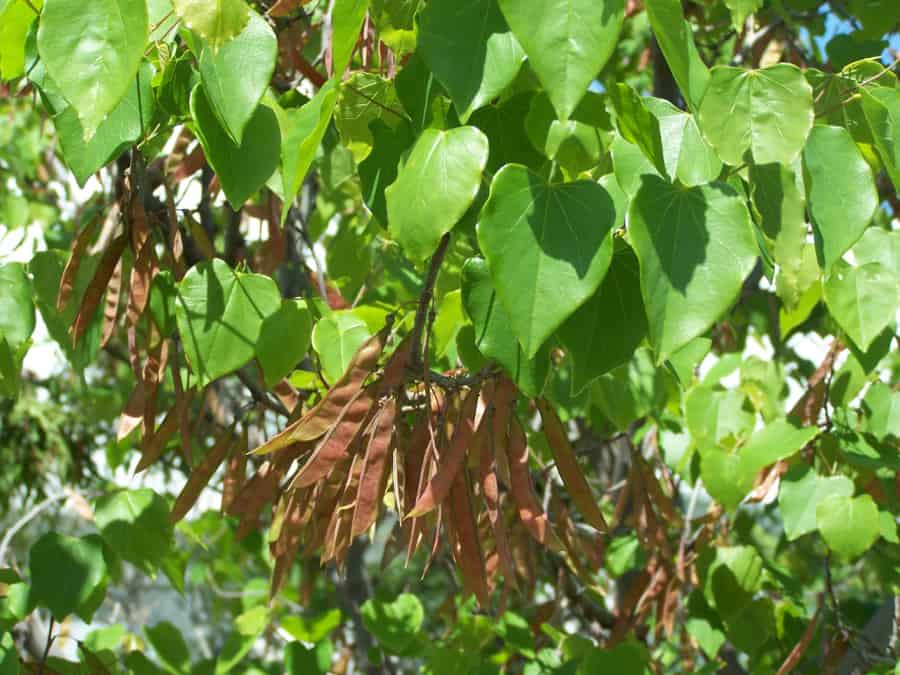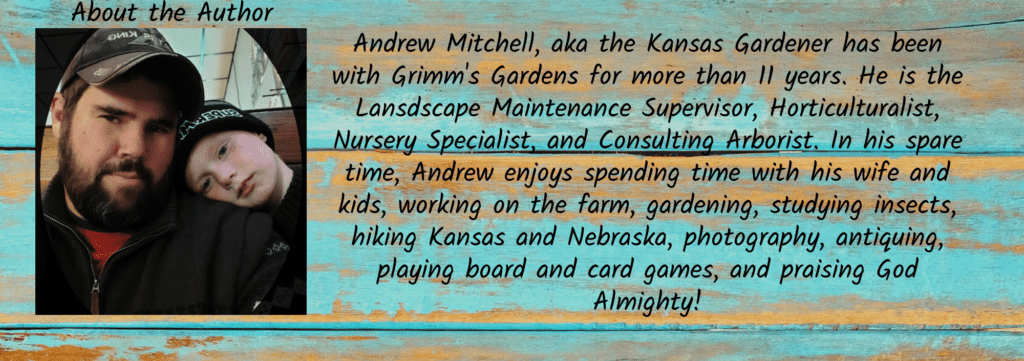The redbud is our April plant of the month for 2022. I have a long love for redbud trees, they have been everywhere I have been. Growing up in North Central Kansas, they were one of the first trees I learned, because they were growing wild in my backyard. I have spent the better part of 35 years loving trees of all kinds, including the redbud.
There are 2 species of redbuds in North American, and eastern variety found east of the Rocky Mountains, and a western variety which is west of the Rockies. We are concerned with the eastern variety. The eastern redbud does have various subgroups, which are more suited to their regions. These include the Oklahoma, Minnesota, and Canadian regional groups.
Here in the Central Great Plains, we can grow any of these subgroups. However, the Canadian and Minnesota cultivars often get leaf scorch in our hot summers, while the Oklahoma ones sometimes die back in harsh winters. But, there are redbuds native to eastern Kansas and southeast Nebraska, which we have chosen cultivars from. What is my hardiness zone?
Growing Redbud Trees
Sometimes, planting is the hardest thing on trees. If they plant themselves (or are seed planted by animals), they only germinate and thrive in the perfect conditions. But we humans are always trying to plant trees in substandard conditions. We regularly try to put trees in newly made lawns of monoculture grass, with daily watering, a place where few trees survive. Sometimes the soil is only a few inches thick, sometimes there is standing water, sometimes we kill the tree by mulching. What can we do to make it better for the tree?
Proper Tree Placement for Redbuds
When we are planning to add a redbud tree to our either new or existing landscape, we need to plan accordingly. Redbuds can grow in some harsh soils and conditions, but what are they? Where are they found in nature? Mostly in understory conditions, in well-drained to dry, rocky soils. In the woods of eastern Kansas, you find them growing under the larger canopies of oak, hickory, ash, and elm. They can also grow well under black walnut, which is notorious for killing plants.
Redbuds do not like standing water or extremely wet feet, though a few cultivars may take lawn irrigation without death. Despite being an understory tree, they really bloom best in full sun. But, because they are early bloomers (March to May), they finish blossom time before the overhead trees have begun to leaf out. Plant them where they can get some sun and wind protection from the west, if possible.
Planting in Clusters or Groupings

Trees are social organisms, just like us. For the most part, humans do better when around other humans, though too many of us cause problems. Trees are the same way. A grouping of trees together thrive off the energy they all share. But plant too many species together, and it gets complicated. Plan to plant at least 3 redbuds together, or plant them within 20 feet of another tree or cluster of trees. My redbuds at home are surrounded by paperbark maples, shagbark hickory, black walnut, apricot, and other redbuds.
What energies do trees share? I have learned through experimentation and reading, that not only do trees have electrical currents flowing in them, that they also share them with other trees. Most of these electrical currents flow as impulses through the ground or touching roots (root grafts). They use these currents to communicate when pests, diseases, or other factors are affecting each other. Even different species send signals, some are electrical, some chemical. This is their own unique language.
For more information on planting trees, click here.
Choosing a Redbud Tree
There are many different types of redbuds to choose from. Not species overall, but cultivars and shapes. While the native redbud tree you dig up from the ditch or plant via seed will most likely grow 25 to 35 feet tall and wide, with a vase shaped crown, you can get all manner of interesting varieties from the nursery.
Weeping or twisted branch trees are perhaps the most interesting forms. These only grow 3 to 10 feet tall and can have green or red/purple leaves, and pink, red, or white flowers. Standard redbuds grow to the size of the natives, but may have purple, green, or yellow/green foliage, as well as white, red, or pink flowers.

Upright Habit Cultivars
Upright habit simply means its not weeping. There are several excellent cultivars to choose from in this category. Finding them might be more difficult, though most nurseries sell at least 2 of them, because redbuds are a popular ornamental tree with few pest issues. More on those later.
- ‘Miss America’ – this selection from Grimm’s Gardens might be one of the best white blooming cultivars soon to come to market. The creamy white flowers open sometimes in March and certainly in April, blooming undaunted for 4 to 6 weeks. Bees hover on the flowers, and in my career at Grimm’s, it has yet to set seed. 25 feet tall and wide.
- ‘Raspberry Twinkles’ – another selection by Doug Grimm, found in Nebraska City, it boasts raspberry pink blossoms in spring that last for 4 to 6 weeks. It grows more upright, 25 to 30 feet tall by 15 to 25 feet wide.
- ‘Royal White’ – one of the industry standards for white flowering, this variety does have seeds. It is very cold hardy and grows 25 feet tall and wide.
- ‘Forest Pansy’ – introduced in 1947, this burgundy leafed variety does best in partial shade. In full sun (in the Central Great Plains), the leaves often fade to dark green in midsummer. Hardy to Zone 5b(6), it grows 25 feet tall and wide.
- ‘Burgundy Hearts’ – a more recent selection from Oklahoma, holds its burgundy colored foliage better in the heat and full sun. It grows 30 feet tall and wide.
- ‘The Rising Sun’ – a newer selection that has brilliant orange new foliage in front of light green leaves. It is a very attractive selection that needs some wind protection. It grows 10 feet tall and wide and is a great specimen tree for small spaces.

Weeping Cultivars
While the number of weeping cultivars is small, these are truly special trees that many people have in their collections. They are great specimens that attract attention wherever they are planted.
- ‘Lavender Twist’ – is perhaps the most well-known weeping redbud in gardening circles. Its bright pink flowers festoon over it in April in a cascade of color. It grows 5 to 7 feet tall and wide, depending on where the graft union is placed on the rootstalk.
- ‘Vanilla Twist’ – is a white flowered version of the above species, growing 5 to 9 feet tall and wide.
- ‘Ruby Falls’ – this weeper has burgundy foliage instead of dark green, with pink flowers. It grows 6 to 8 feet tall and wide and is cold hardy to Zone 5.
Problems and Pests of Redbud
We choose the plant of the month, not only for what it does during year, but also how many pests and problems affect it. Redbuds are easy to grow once the roots are established, and only a handful of pests affect it, none of them are life-threatening. Most of the issues that kill redbuds are due to improper planting or storm damage.
Insect Pests
While there are no major insect pests of redbuds, there are several that use the tree as a host plant. These include the Henry’s Elfin butterfly, and several moths. The most interesting moth is the redbud leaf folder, which folds over a leaf a home for the developing caterpillar.
Environmental Problems
Redbuds have somewhat brittle stems and often lose large branches and many leaves in windstorms, tornadoes, and ice. During dormancy, which usually runs from September to February in the Central Great Plains, redbuds actually pull all the sap from the tree branches into the roots. So the tree appears dead during this time.
Scorch is also a problem for trees planted in full sun in southern locations, especially if they are northern selections or cultivars. Scorch happens when too much sunlight is hitting the newest parts of the leaves and turning them brown or black, literally scorching them with heat.
Seedpods
Redbuds have annoying seedpods. Because they are a legume, they use bacterial to produce nitrogen in the roots, but they also have a skinny, bean-like pod that contains several seeds. While the seedpods can be somewhat ornamental while on the tree, they are annoying when hundreds of seedling redbuds grow in the lawn the next season. Look for varieties that are seedless, like ‘Miss America’.

Conclusion
Redbud trees are very showy and ornamental and come is a wide range of shapes, leaf colors, and flower colors. You can fit them into any garden, regardless of size. I love the look of shimmering pinks in early spring in the woods of Northeast Kansas, all from redbuds. Add one to your garden today.
Happy planting!




